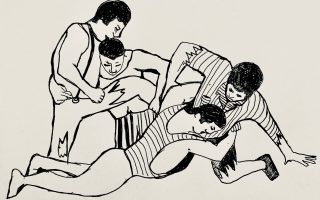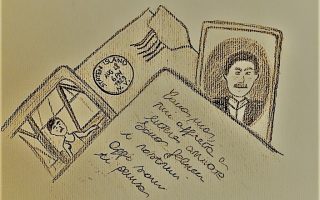by SALVATORE PANE
I don’t know why, but the trend these days is to build banks in strip malls. There are no vaults, no elegant ceilings, rarely more than a lone yawning teller. My financial institution looks more like a cell phone store or a child’s drawing of a bank, stripped of detail or anything that might inspire even the slightest shred of confidence. I couldn’t get this out of my head while sitting next to my wife in a cramped credit union tucked behind the Roseville Mall and a Raising Cane’s. We’d moved to Minnesota nine years prior, but neither of us had been willing to surrender our East Coast bank accounts. Only now, on the precipice of buying a home, did we accept that we needed the backing of a local bank.
The financial advisor sat behind a desk lacking all personal touches. No pictures. No tchotchkes. No calendar of Garfield clinging on for dear life. She tapped her tablet before biting her lip in nervous anticipation. “It’s really important to the bank,” she said, trailing off. “I mean, it’s really important to me, to all of us here, that we pronounce your name right. Is it Sail-vay-tory?”
My wife’s lips curled, and I knew she was fighting back laughter. This wasn’t the first time someone expressed astonishment over my name since arriving in the flat geography of the Midwest, and it wouldn’t be the last. “Sal is fine,” I gently explained. “It’s Italian.”
“Oh,” she said, unsure how to register this new morsel of information. “Wow. I’ve never heard that before.”
Growing up in Scranton, Pennsylvania—an enclave of Italian Americans made up of Sicilians and Neapolitans who trekked across the Atlantic to toil in the rich veins of anthracite underground—this reaction would’ve been impossible. My father’s name is Sal. My uncle’s name is Sal. My great grandfather’s name was Sal. There was another Sal on my Catholic school basketball team, even though our class only totaled 11 rangy, depressed teens. You couldn’t step outside without bumping into a Sal or Mario or Gianna. Pizza shops lined the avenues, and personal milestones—graduations, weddings, funerals—were hosted at La Cucina or Villa Maria II or the Cataldo Club. Every summer kicked off with men racing the statue of Saint Ubaldo down the hilly streets of Jessup and climaxed in La Festa, a celebration that closed all of downtown, the courthouse swarmed by tricolor stands hawking porchetta and cannoli and lasagna. In the words of Bollywood icon Shah Rukh Khan, “We [were] everywhere, sweetheart,” and I naively believed that the reality of Scranton was ubiquitous. This belief persisted when I went to college 90 minutes away and after I moved to Pittsburgh following graduation—spending my days in that city of bridges inhaling pizza from Mineo’s or playing bocce with the old timers during Little Italy Days. The truth only dawned on me when at 30 I moved with my then-fiancée to the frozen hinterlands of Minnesota, when I bit into my first slice of Pizza Luce—cardboard thin crust, a single dollop of lifeless red sauce, cheese that can only be described as insulting, and a mountain of inexplicable and frankly alarming toppings—and turned to my wife and asked, “What fresh hell is this?” Over and over, people remarked on my “exotic” name. Over and over, I descended like Dante into the hot bowels of some eatery promising authentic Italian food only to emerge an hour later confused and angry and hungry.
By the time I landed in St. Paul, I’d published a coming-of-age novel and had two additional books in the pipeline. But I’d never written a single line about being Italian American. Living on the East Coast, it seemed too ordinary and blasé—akin to writing a novel pondering over whether the sky is occasionally blue. But as each new winter erased Minnesota, my imagination escaped to the stomping grounds of my youth, probing those idyllic and stereotypical images—the babushka-ed nonna huddled over a steaming pot of red sauce, dancing the tarantella at a wedding while guests palmed envelopes filled with cash, the inky black crosses smeared across foreheads as churchgoers evacuated mass. I wrote my very first short story about the Italian American experience while living in Minnesota. Then I wrote another. And then I traveled to Milan and Turin for a week-long conference, and then, because of work, I lived in Rome for three months. Nine years passed, and finally I published a collection of this material, The Neorealist in Winter, containing eight stories about Italian Americans in the US, two about Italian Americans in Italy, and one about Italians in the homeland. I embarked on a modest book tour, visiting my familiar haunts in St. Paul, flying back to Pittsburgh, driving four hours to Milwaukee—I’ll be speaking in Boston next month. And inevitably, at the end of these sessions, some good-natured soul kind enough to endure a reading will rise from their chair and ask, “But what does it mean to be Italian American today?”
Every single time I struggle with that question, and it’s unclear to me if that’s evidence that Neorealist is a success or a failure. I hem and I haw. I namecheck my cat Martin Scorsese the Cat. I suggest replacing Columbus statues with the proud visage of one Giancarlo Esposito. I turn evasive and blank, much like when confronted by the well-intentioned employees of the credit union who only want to correctly produce my name. But deep down I have an inkling. A sense of things. I can only speak to my own experience, to what I’ve observed, but being an Italian American today, a century removed from the writer Pascal D’Angelo’s Son of Italy—his great work on the immigrant experience—feels like groping through a funhouse mirror maze.
Italian Americans—perhaps more than any other white community who emigrated from Europe—have almost always seen themselves reflected in media. The easiest example is The Godfather, the ur-text for all Italian Americans. Say what you will about media portrayals of the mob, but Francis Ford Coppola devoting the first 27 minutes of his film to Connie’s wedding makes his intentions clear. Sure, the celebration’s interspersed with Buonasera’s prophetic “I believe in America” and the career machinations of fading crooner Johnny Fontane, but the wedding itself is shot as a quasi-documentary, and for those of us born after the film’s 1972 release or even the post-World War II milieu when the movie’s set, this is the closest we’re ever going to get to home movies from that period. How many Italian American families have regurgitated the rituals of Connie Corleone’s wedding not because these are time-honored family traditions, but because The Godfather made us believe they’re time-honored family traditions? We don’t know what we don’t know, but we do know The Godfather. And we know Mean Streets. And we know GoodFellas. And we know Saturday Night Fever and Moonstruck and My Cousin Vinny and the list goes and on and on in a way it doesn’t for the German American community or Irish Americans.
I was a scant thirteen years old when The Sopranos premiered on HBO in 1999. Led by showrunner David Chase—note how David lopped off the DeCesare from his surname in favor of the empty Chase—series lead Tony Soprano wrestles constantly with his identity. In the pilot, he tells his therapist, “It’s good to be on something from the ground floor. I came too late for that. I know. But lately I’m getting the feeling that I came in at the end. The best is over.” This oft-cited monologue reflects Tony’s feelings on the mafia as it enters the new millennium, but it’s also a metaphor for what so many Americans felt in those final waning days before 9/11 and the sheer madness of the two decades that followed. Less discussed are its obvious connections to the non-crime Italian American experience. How can any Italian American really embody this identity three or four generations removed from our European exodus? How can an Italian American embody this identity in a frozen tundra where people can’t pronounce the name Salvatore? How can an Italian American embody this identity when they don’t know any traditions they haven’t observed from TV and have never in their life tasted homemade pasta? The Sopranos is a TV show about mobsters impersonating mobsters—Silvio often demonstrates his Pacino impression while Paulie Walnuts’ car literally honks the theme to The Godfather. These characters are not reflections of real life like in The Godfather. They’re reflections of reflections. 25 years removed from the series premiere, and this problem has only intensified. I too am a reflection mimicking cultural heritage passed on by other reflections. A photocopy of a copy of a copy. We are all of us in our own way shadows, the twisting shapeless people of the funhouse mirror, ready and eager to transform.
#
Last summer, I traveled to Palermo to finish The Neorealist in Winter. I stayed in the mansion-turned-apartments of the late Giuseppe Di Lampedusa, the great writer of The Leopard and the former Prince of Lampedusa to boot. Whenever I visit Italy, I’m seduced by the braindead albeit beautiful fantasy that I will somehow find my European family. I haven’t seen most of my family in America for nearly a decade, and maybe that’s where all of this stems from. I researched my people, tracked them down to the little village of San Cataldo, but, on the critical day of departure, I didn’t go. I remained in Palermo instead, drinking cocktails with my wife and the other tourists. I told a waitress that my people came from San Cataldo, and she told me she grew up down the road. We were paesani, she proudly explained. I met a Sicilian banker and his Ukrainian wife, and he asked me over wine if I was proud of my Sicilian blood. That night, my last in Palermo, I walked back to the mansion-turned-apartments and saw a white convertible cab roar down the cobblestone near the Tyrrhenian Sea. A woman in a black swishy maxi dress stood on the back seat, gripping a handrail installed for exactly this purpose. An obvious tourist, she chugged from a bottle of prosecco and screamed, “Woo hoo!” and the cabbie—in a clear attempt to run up his tip—smashed the car horn and flooded the streets with The Godfather theme blasted loud from his speakers. I stood gobsmacked with my wife, and we watched the cab disappear into the shadows of Palermo.
Salvatore Pane is the author of five books, the most recent of which is The Neorealist in Winter. His short work has appeared in Prairie Schooner, Indiana Review, and American Short Fiction. He is an associate professor at the University of St. Thomas where he teaches English and Italian film. Reach him at www.salvatore-pane.com.
Read it in italian by clicking here




